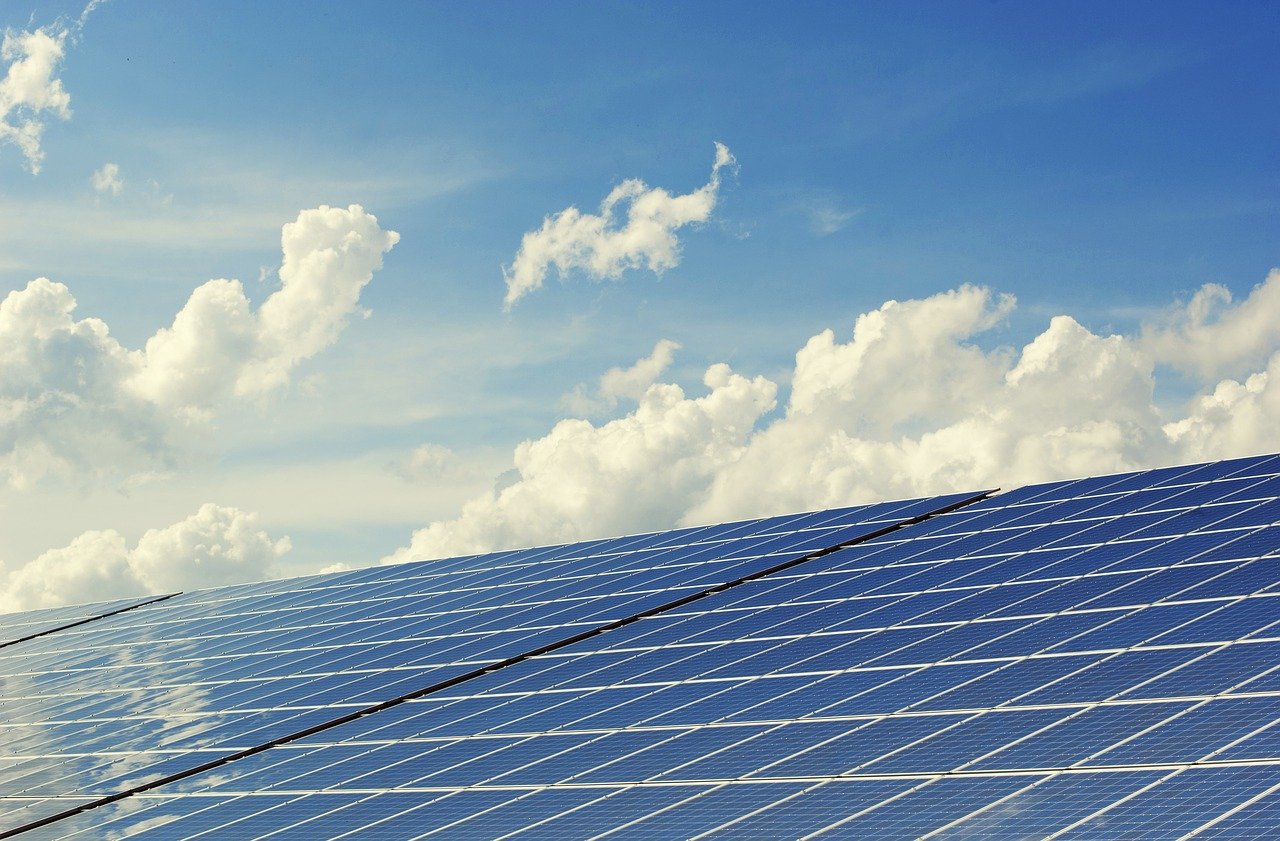Solar energy
The sun is the main source of energy on Earth, because about 173 PW (or 173 million GW) of solar energy reaches our planet every year, which is more than 10,000 times the world’s energy needs. Photovoltaic modules on rooftops or outdoor areas convert sunlight into electrical energy using semiconductors – mostly silicon. Solar collectors produce heat for heating and hot water production, as well as for air conditioning.
Solar panels can produce power even when it’s cloudy and even when it’s snowing. For best efficiency, they should be installed at a certain angle – the farther away from the equator, the greater the angle of the panels.
Wind energy
Using wind as a driving force is a long tradition. Windmills were used for grinding flour, sawmills) and as a pumping or water pumping station. Modern windmills generate electricity from wind power. They first turn the kinetic energy of the wind into mechanical energy of the rotor, and then into electrical energy.
Wind power is one of the fastest growing renewable energy technologies. According to the latest IRENA data, the world’s onshore and offshore wind power capacity has grown nearly 75-fold over the past two decades, from 7.5 GW in 1997 to about 564 GW by 2018.
Water power
As far back as ancient Egypt and the Roman Empire, water power was used to drive working machines, including mills. In the Middle Ages, water mills were used in Europe in sawmills and pulp and paper mills. Since the end of the 19th century, water energy has been used to generate electricity.
Geothermal energy
Geothermal energy uses the heat from the earth to produce electricity. The temperature in the earth’s crust can heat the upper layers of the earth and the reservoirs beneath it. Geothermal energy is extracted from the ground using shallow wells – this does not require much capital investment. It is especially effective in regions where hot springs are close to the surface of the earth’s crust.
Bioenergy
Bioenergy is versatile. Heat, electricity and fuel can be produced from solid, liquid and gaseous biomass. At the same time, plant and animal waste is used as a renewable raw material.
Tidal energy
Tides and waves are another way to generate energy. They make the generator rotate, which is responsible for generating electricity. Thus, wave power plants use hydrodynamic energy, i.e. the energy, pressure difference and temperature difference of sea waves, to generate electricity. Studies in this area are still underway, but experts have already calculated that the European coast alone could generate more than 280 TWh of energy annually, which is half the energy consumption of Germany.
How different countries around the world are implementing energy transition plans
Countries around the world have set ambitious targets for the transition to renewable energy. The goals are also part of the Paris Agreement – by 2030, zero-carbon solutions can be competitive in sectors that account for more than 70% of global emissions. This is to be done through the energy transition, the process of replacing the coal economy with renewable energy. In 2020, despite the pandemic and economic recession, many cities, countries and companies continued to announce or implement decarbonization plans.
India is expected to make its biggest contribution to renewable energy in 2021. It plans to launch a number of wind and solar projects.
The European Union is also forecast to see a jump in capacity growth in 2021. Here, even in a pandemic, they do not forget about the Green Deal – the largest economic course correction in the history of the EU. The goal of the project is to form a carbon-neutral space in the EU by 2030. For this purpose, it is planned to reduce the volume of greenhouse gas emissions by 40% of the 1990 level and to increase the share of energy from renewable sources to 32% in the total energy consumption structure. According to the European Commission, it will be possible to achieve these goals by means of annual investments in the amount of €260 billion. The share of renewables in the EU energy system is also constantly growing. For example, in the first half of 2020, about 40% of electricity in the EU was generated from renewable sources.
So far, the leaders in investment in the development of renewable energy are China, the U.S., Japan, and the UK. Since BloombergNEF began tracking this data, global investment in wind and solar power, biofuels, biomass and waste, and small hydropower has increased by almost an order of magnitude. In annual terms, investment in clean energy has grown from $33 billion to more than $300 billion over 20 years.
In ten years, China has become the main producer of renewable energy equipment. First and foremost, we are talking about solar panels. Seven of the ten largest solar panel manufacturers in the world are Chinese companies. In general, the development of technology has made it cheaper to build new renewable energy facilities. This brings China’s plans to become carbon neutral by 2060 closer.


